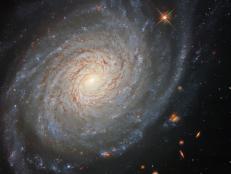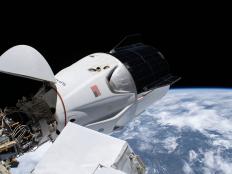All Space Articles
Showing 76 - 90 of 491 results
William Shatner Becomes Oldest Man to Travel to Space After Successful Blue Origin Space Flight
On the morning of October 13, William Shatner joined the crew of New Shepard for its second crewed flight, NS-18. Due to a few holds, the scheduled 10A liftoff was delayed by about 50 minutes from Blue Origin's Launch Site One in Texas. Despite the delays, liftoff and touchdown went off without a hitch, making Star Trek star William Shatner the oldest man to go to space.
The Best Planets are Rogue Planets
We can debate the status of objects in the solar system all day long, arguing if little Pluto is a planet or not. But to tell you the truth, any planet in any solar system got the short end of the stick. The real winners of the galactic game are the travelers, the roamers, the rogue planets.
India’s Space Agency is Going Big… By Going Small
Astrophysicist Paul M. Sutter shares the latest in the world of rocket launches and what India’s SSLV is all about.
10 Facts About NASA’s SpaceX Demo-2 Splashdown
Here's everything you need to know about NASA astronauts Bob Behnken and Doug Hurley's return home from the International Space Station on Sunday, August 2.
Success! NASA and SpaceX Crew-1 Complete Early Morning Splashdown
(Updated: May 2, 2021) NASA astronauts Michael Hopkins, Victor Glover, Shannon Walker, and JAXA astronaut Soichi Noguchi completed a successful splashdown on Sunday, May 2, after a 165-day space research mission aboard the International Space Station. Here is what we know about their return to Earth.
First US Commercial Crew Port Relocation to Air Live on NASA TV
On Monday, April 5, another first will occur for commercial space flight. For a look back at Crew-1's initial journey to the ISS, catch up on SPACE LAUNCH LIVE streaming now on discovery+.
The Perseid Meteor Shower Reaches its Peak
Stargazers rejoice! The annual Perseid meteor shower is upon us. Here's what you need to know...(updated August 11, 2022)
Voyager 2 is Really Far Out There, Man
Currently Voyager 2 is about 11 billion miles from the Earth, and has been traveling at speeds of tens of thousands of miles per hour since its launch in 1977. Read more to see where it is now and what we've learned.
NASA’s $10 Billion Space Telescope Hit by Micrometeoroid
NASA’s new James Webb Space Telescope (JWST) was recently hit by a micrometeoroid. One of the 18 golden mirror segments on the telescope was hit, causing some minor damage.
Why Pluto Isn’t a Planet, but (Maybe) Should Be
What, exactly, is a “planet”? For ancient astronomers it was pretty easy. When they stared up at the night sky, they saw a) the sun, b) the moon, c) a lot of fixed stars, d) a few wandering points of light. Those vagabonds were the planets. Indeed, our word planet comes from the Greek word for “wanderer”.
NASA Has a New Supersonic Jet and It’s Super-Quiet
There’s more to NASA than space. The agency’s full acronym stands for National Aeronautics and Space Administration. I’ve covered plenty of interesting stories in the space sector, so it’s time to the aeronautics side some love too.
The Top 5 Weirdest Moons of the Solar System
From the exotic to the just plain odd, our solar system is home to some of the most extreme worlds in the galaxy. But I’m not talking about the planets, I’m talking about their moons. Let’s take a look at the most strange...
When Did the First Stars Shine?
Our universe is home to up to two trillion galaxies, with each galaxy hosting hundreds of billions of stars. That’s…a lot of stars. Each one a ball of fearsome energies, powered by the nuclear fusion of fundamental elements in their hearts. Each one pouring out light into the empty cosmos, illuminating our universe for our wonder and delight.
Expedition 63 to Return Home on October 21
After 196 days in space aboard the ISS, NASA astronaut Chris Cassidy, Roscosmos cosmonaut Anatoli Ivanishin, and Roscosmos cosmonaut Ivan Vagner are coming home! Let’s learn the details of their return to Earth.
November: What's New in Space Exploration This Month?
It’s a November to remember in space. Here are some exciting space exploration highlights to look forward too!


























